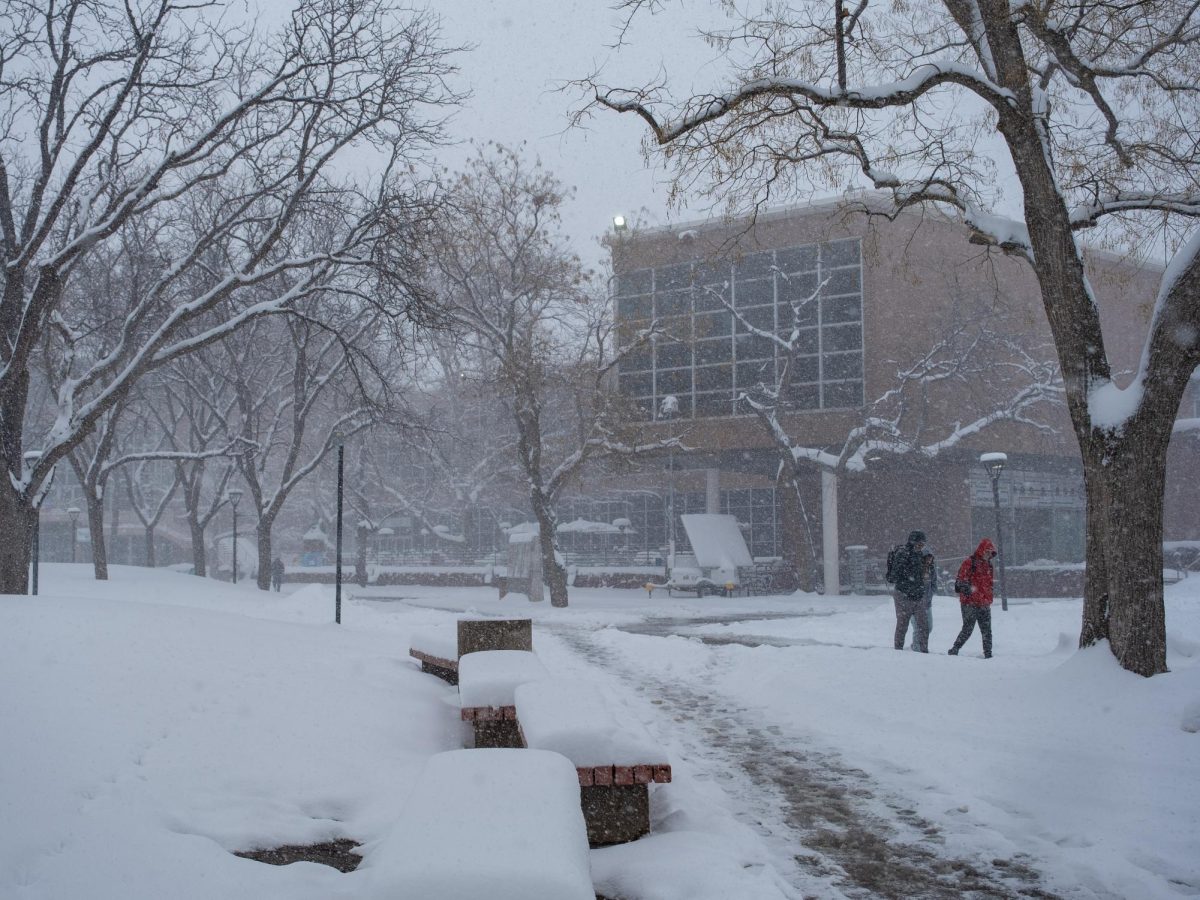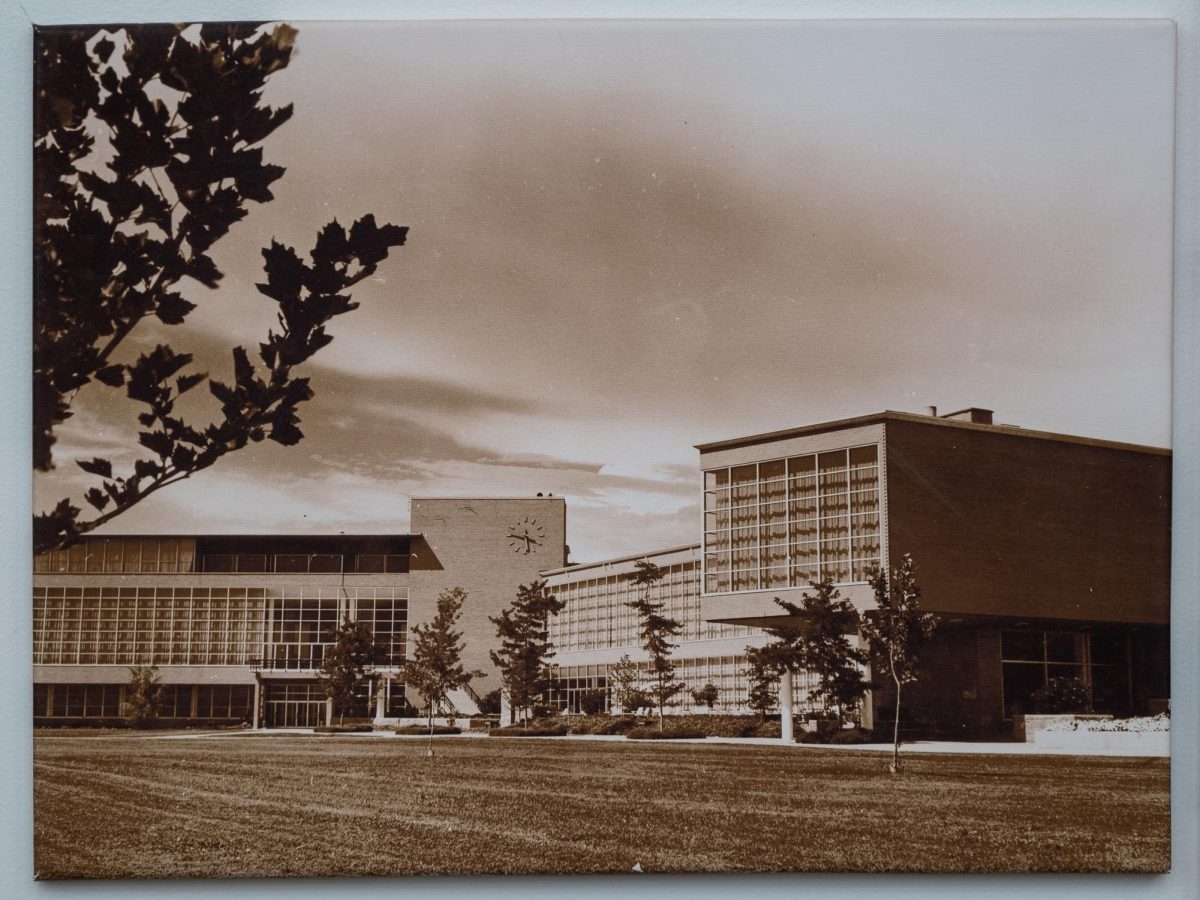U Origins: How Landscaping Projects in the 1970s Ended On-Campus Protests
A historical photo of the A. Ray Olpin Student Union. (Courtesy of J. Willard Marriott Library Special Collections)
July 8, 2023
“We set out to visually express the character and dignity of the U in an atmosphere which is cheerful, peaceful and ecologically sound,” said Bruce Jensen, former director of campus planning at the University of Utah.
This statement came in 1971, following the completion of an enormous landscaping project that marked the origin of the current wooded, hill-covered landscape that surrounds the Union building today. The origins of this project are believed to be rooted in student protests of the Vietnam War on the Union lawn in the late 1960s and early ‘70s, according to campus legend.
Landscaping projects had been well underway at the time of these protests. Records show project plans began as far back as 1967, however, documents show that in the years following intense protests in May 1970, significant changes were made to existing plans.
In April 1970, the U.S. military invaded Cambodia in what is known as the “Cambodian incursion.” This came at a high point of civilian disapproval of the war in Vietnam. Although this disapproval was fueled by many factors, a large part of the anti-war sentiment was driven by opposition to the draft.
The draft called on men between the ages of 18 and 26 to serve in the U.S. military. Although university students could qualify for student deferment, the possibility of being drafted made their futures beyond graduation uncertain. This sentiment culminated in an explosion of protests on university campuses across the country with the news of a further invasion of Cambodia.
By early May 1970, the news of the invasion had radiated through universities across the country. Protests later broke out, including a demonstration at the U that centered in the open, flat and highly visible lawn of the Student Union.
According to library archives, “After the deaths of four students at Kent State University in Ohio on May 4, 1970, students rioted at the University of Utah. Classes were disrupted, the Daily Utah Chronicle offices were occupied, and the ROTC building was fire-bombed.” The next morning, the National Guard headquarters building was bombed.
Additionally, newspaper records indicate that a student protest on May 11, 1970 was the origin of a fire that ignited in the neighboring Intercultural Center, which had been abandoned and was set to be demolished the following week.
It was after these protests that the U first created its campus police force.
Prior to the summer of 1970, the lawn between the Union building and the Marriott Library was very open and visible with little to no trees. The ground was also relatively flat, making it a common place for student protests during the 1960s.
Marriott Library archives reveal a campus legend that states that “the hilly landscaping around the Union building was put in place to deny rioting students a place to assemble, and that the sidewalks on campus were purposely made wide enough to [accommodate] an army truck.”
Prior to the protests of 1970, Campus Planning Department memos indicate that the landscaping projects during the late 1960s were originally intended to provide a place for students to congregate.
“We … recognize the need for one single large gathering place on campus for students,” said Arden Larson of the Campus Planning Department in a memo from February 1970, just months before the protests. “The practical and sensible location is near the Student Union building where the largest share of student activity is .… this area could be designed as an area where student rallies could be held.”
The lawn outside of the Union building does not fit this description. In its present form, the Union lawn contains a large mass of tall trees and five-foot-mounds of grass. It lacks its previous expanse of flat ground, limiting visibility in the landscape and making it a less convenient spot for students to gather, despite still being a central location for student traffic.

The once open-style area of the Union lawn that was so attractive to students to host rallies and demonstrations was not always supposed to be morphed into the tree-covered lot, according to U archives.
In Larson’s memo, he outlined recommendations to maintain this open style.
“The designer should make certain not to plant grass on slopes with more grade than a 4:1,” Larson said, meaning no more than one foot of rise per four feet of distance in the landscape.
The hills on the Union lawn in its present form indicate that this guideline was disregarded.
Larson continued by recommending laying gravel or stones rather than the trees we see today.
When asked about the “mound concept” by the Society for College and University Planning, Jensen said the mounds would create “visual screens” to serve as sound barriers. On top of blocking out visibility and sound, the mounds would channel the foot traffic, according to the SCUP.
Even before the trees had grown to the heights they currently have, the SCUP noted that there was a heavy emphasis placed on tree planting. In total, the project planted over 2,000 trees. The project also included three 25-ton granite stones set to fill the area once used for protesting.
The reasons for this change from an “area where student rallies” could be held to a place of “visual screens” and “sound barriers” are spelled out in several archived memos sent to the then-director Jensen.
One such memo comes from campus planning department member B. Blain Bradford, who expressed concern about rocks as a potential riot “hazard,” alluding to the danger of students using them as weapons.
“I received a memo … posing the hazard that the rocks to the east of the Union building … could be if we were to have a riot on campus,” Bradford said, alluding to a previous discussion on student demonstrations. “I agree with your recommendation that something needs to be done to alter that situation.”
Additionally, interview records from prior student journalists show budget discrepancies between initial price allotments from the University Institutional Council and final project expenditures, indicating that significant expenses were added by numerous alterations to the original plans.
In the same memo from February 1970, department member Larson offers a specific total budget.
“The total construction budget for this project will be $155,000,” Larson said.
Later excerpts from newspaper articles indicate a final project price tag of over $300,000, almost doubling department projections after alterations from the original landscaping plan.
The ability to protest is highly valued by students at the U. Maggie Pozo, a second-year biomedical engineering major and part of the executive board of the Latinx Student Union, describes protesting as “the magnitude of people coming together from many different backgrounds. … It is truly such a powerful feeling walking together united about what we are passionate about.”
Pozo, who has been involved in protests since middle school, also said that “while the U may acknowledge what is going on, they don’t amplify student voices and instead passively listen. The U can improve on how they can really listen to the student body, student organizations and protests in general to make a positive change.”










